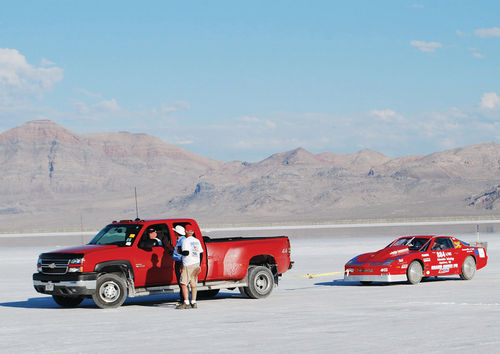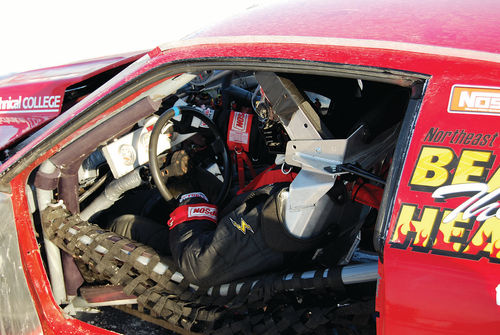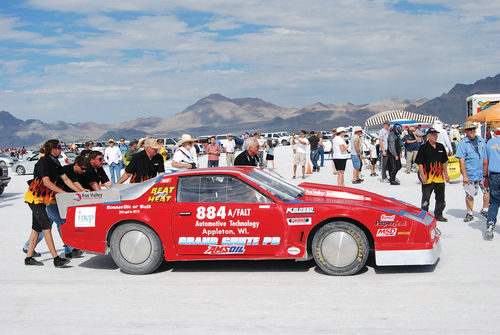Diary of a Salt Flats Racer, Pt. 2
Even After Months of Preparation, Things Can Go Wrong. Then They Were Ready for Another Try When…
AS WE LEARNED last month, Auto Technology Instructor Dave Sarna had “dragged” me to Utah as part of his Bonneville racing team. Prior to that, in the well-equipped J.J. Keller Transportation Center at Wisconsin’s Fox Valley Technical College (FVTC), we had prepped a fast Firebird and a cool Camaro for entry in the Utah Salt Flats Racing Association (USFRA) “World of Speed.” This venue is held in September (saltflats.com).
FVTC was one of four schools competing in the Land Speed record racing event. Brigham Young University’s School of Technology had entered a unique electric streamliner powered by 888 power tool batteries. The Utah State University Mechanical & Aerospace Engineering Department’s entry was a second alternative fuel vehicle—a bio-diesel streamliner. There also was a record holding big-block El Camino entered by the Utah Valley University Department of Automotive Technology.
Two Cars & a Trailer
We had brought two cars so that members of our team could attempt to qualify the blue Camaro in the 130-mph class. Dave Sarna was the only member of the team with the type of Bonneville license required to take a shot at the 200-mph barrier. He would be driving the red Firebird with its 440-cid big-block Chevy V-8, a nitrous oxide system, GM 200-4R 4- speed overdrive automatic transmission, a Ford 9-inch rear axle, racing tires, a full roll cage, a parachute and two special foam fire extinguishers. The Camaro, on the other hand, was basically a street car with some tuning and borrowed racing tires.
From his two previous trips, Sarna knew that the early bird gets to “worm” in a few extra runs at Bonneville so the Firebird’s enclosed trailer was parked in the pits and buzzing with activity as the sun rose. That trailer would serve as a shelter from rain and wind over the next five days in addition to functioning as an impromptu machine shop, a lunch wagon and a repository for everything from pith helmets, straw hats and sun glasses, to toolboxes, driving suits, laptops, jacks, fast food lunches, wheels and tires, sweaty T-shirts and rain-soaked jeans.

Inspection Time, Then a Problem
A lot of wrenching would be done in and around that trailer while it was parked on the salt flats. It was a bit ironic that the Firebird that had received the most attention back at the school was the car that gave us the most troubles on the salt. The Camaro just did its job time after time, although it was not subjected to the same speeds and forces as the Pontiac.
The first order of business on Saturday, September 8, was to get the Firebird through its first technical inspection so that it could join the line of cars waiting to make their runs. At the time, there was only a minor issue with fasteners holding the “moon disc” racing hubcaps on the car.
Finally, the car was ready to “go through tech.” USFRA officials go over everything from wheels and tires to safety gear like gloves and fireproof hoods. The rules also require a HANS (Head and Neck Support) device—a brace that attaches to the driver’s helmet and is designed to keep the neck and head from whipping forward during a high-speed crash. Sarna borrowed his along with a Top Fuel driver’s suit, which also is required for over-200 mph runs. In addition, officials checked for the special foam fire extinguishers that can be driver-activated. One extinguisher covers the driver’s compartment and the other protects the engine compartment.
Sarna paced nervously as the Firebird got the first of its three 2012 inspections. After officials approved the car for a run, it was towed about five miles from the pits to the High Speed Course starting line. After waiting an hour or more on line, Sarna made a run that was timed at 193 mph. It was the highest speed he had achieved and would also be the high for this trip.
When the car got back to the pits, most of the team gathered around for a report on the run. Sarna stated that he had hit the button to turn on the nitrous oxide…and nothing happened. He had not gotten the expected boost and burst of speed needed to sail past the 200-mph mark.
Several members of the crew got the tools out and went to work. According to team member Jim Buchman, “The problem with the nitrous was that it was hooked up wrong electrically. We tried to track down the problem, but in the end we just cut the wires and ran a new power wire to fire the solenoids on the carburetor.”
With the new setup in place the Firebird was ready to try for a second run late Saturday afternoon. Team member Tom Ales used his big red pickup to pull the Firebird to the staging area once again. Then, during the long wait for the run, the Firebird’s hood and trunk seams were again taped up to improve the car’s aerodynamics.



Meanwhile, young members of the team were qualifying with the Camaro on the three-mile Short Course for 130- and 150-mph timings. That course sits a long walk off to the right of the seven-mile Long Course where the Firebird made its runs and goes at a 50-degree angle toward the east. Young team members used a four-wheel ATV to go back and forth between the Camaro and the Firebird.
Ready…Set…Wait
Although we were ready to go, “World of Speed” racing ends promptly at 6 p.m. and at that time the Firebird was the third car in one of the two lines of vehicles creeping up to the starting position.
USFRA officials announced that racing had ended for Saturday, but that we would get the same slot to run the next morning. They gave us the option of leaving the car at the starting line overnight or towing it five miles to the pits and five miles back to the starting line on Sunday morning.
Considering potential weather conditions, we took the option of bringing the Firebird back to the pits and parking it in the relative safety provided by our trailers and tents.
Next time: A pinion bearing swap and A-frame weld-up on the Salt Flats.
















